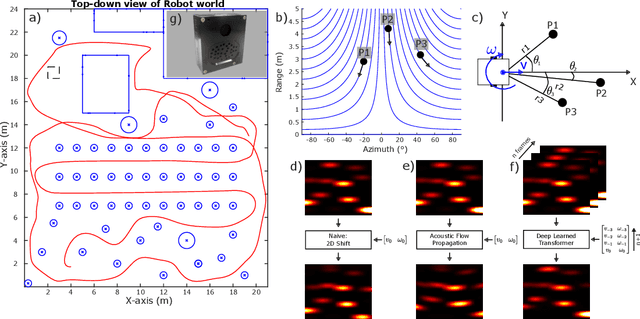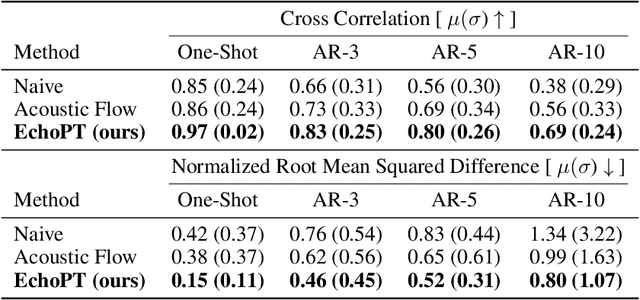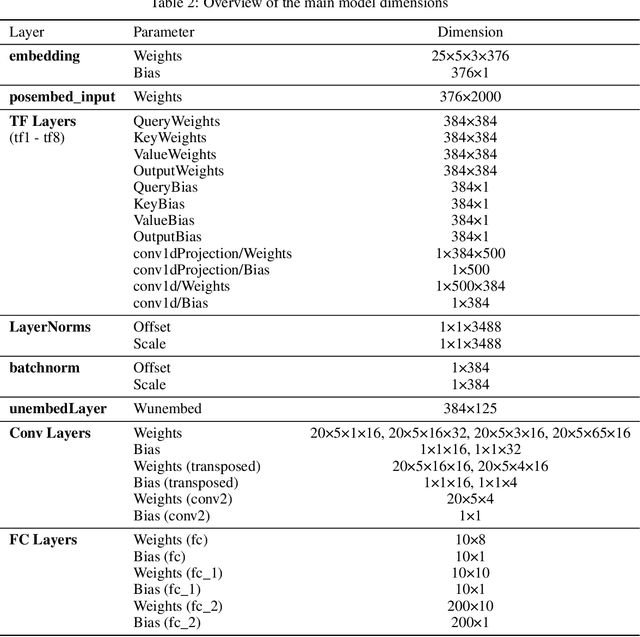Jan Steckel
A Wireless Self-Calibrating Ultrasound Microphone Array with Sub-Microsecond Synchronization
Jun 24, 2025Abstract:We present a novel system architecture for a distributed wireless, self-calibrating ultrasound microphone network for synchronized in-air acoustic sensing. Once deployed the embedded nodes determine their position in the environment using the infrared optical tracking system found in the HTC Vive Lighthouses. After self-calibration, the nodes start sampling the ultrasound microphone while embedding a synchronization signal in the data which is established using a wireless Sub-1GHz RF link. Data transmission is handled via the Wi-Fi 6 radio that is embedded in the nodes' SoC, decoupling synchronization from payload transport. A prototype system with a limited amount of network nodes was used to verify the proposed distributed microphone array's wireless data acquisition and synchronization capabilities. This architecture lays the groundwork for scalable, deployable ultrasound arrays for sound source localization applications in bio-acoustic research and industrial acoustic monitoring.
Phase-Center-Constrained Beamforming for Minimizing Phase-Center Displacement
Mar 26, 2025Abstract:Accurate knowledge and control of the phase center in antenna arrays is essential for high-precision applications such as Global Navigation Satellite Systems (GNSS), where even small displacements can introduce significant localization errors. Traditional beamforming techniques applied to array antennas often neglect the variation of the phase center, resulting in unwanted spatial shifts, and in consequence, localization errors. In this work, we propose a novel beamforming algorithm, called Phase-Center-Constrained Beamforming (PCCB), which explicitly minimizes the displacement of the phase center (Phase Center Offset, PCO) while preserving a chosen directional gain. We formulate the problem as a constrained optimization problem and incorporate regularization terms that enforce energy compactness and beampattern fidelity. The resulting PCCB approach allows for directional gain control and interference nulling while significantly reducing PCO displacement. Experimental validation using a simulated GNSS antenna array demonstrates that our PCCB approach achieves a fivefold reduction in PCO shift compared to the PCO shifts obtained when using conventional beamforming. A stability analysis across multiple random initializations confirms the robustness of our method and highlights the benefit of repeated optimization. These results indicate that our PCCB approach can serve as a practical and effective solution for decreasing phase center variability.
Tool Wear Prediction in CNC Turning Operations using Ultrasonic Microphone Arrays and CNNs
Jun 13, 2024Abstract:This paper introduces a novel method for predicting tool wear in CNC turning operations, combining ultrasonic microphone arrays and convolutional neural networks (CNNs). High-frequency acoustic emissions between 0 kHz and 60 kHz are enhanced using beamforming techniques to improve the signal- to-noise ratio. The processed acoustic data is then analyzed by a CNN, which predicts the Remaining Useful Life (RUL) of cutting tools. Trained on data from 350 workpieces machined with a single carbide insert, the model can accurately predict the RUL of the carbide insert. Our results demonstrate the potential gained by integrating advanced ultrasonic sensors with deep learning for accurate predictive maintenance tasks in CNC machining.
Broadband MEMS Microphone Arrays with Reduced Aperture Through 3D-Printed Waveguides
Jun 11, 2024Abstract:In this paper we present a passive and cost-effective method for increasing the frequency range of ultrasound MEMS microphone arrays when using beamforming techniques. By applying a 3D-printed construction that reduces the acoustic aperture of the MEMS microphones we can create a regularly spaced microphone array layout with much smaller inter-element spacing than could be accomplished on a printed circuit board due to the physical size of the MEMS elements. This method allows the use of ultrasound sensors incorporating microphone arrays in combination with beamforming techniques without aliases due to grating lobes in applications such as sound source localization or the emulation of bat HRTFs.
Stabilized Adaptive Steering for 3D Sonar Microphone Arrays with IMU Sensor Fusion
Jun 10, 2024Abstract:This paper presents a novel software-based approach to stabilizing the acoustic images for in-air 3D sonars. Due to uneven terrain, traditional static beamforming techniques can be misaligned, causing inaccurate measurements and imaging artifacts. Furthermore, mechanical stabilization can be more costly and prone to failure. We propose using an adaptive conventional beamforming approach by fusing it with real-time IMU data to adjust the sonar array's steering matrix dynamically based on the elevation tilt angle caused by the uneven ground. Additionally, we propose gaining compensation to offset emission energy loss due to the transducer's directivity pattern and validate our approach through various experiments, which show significant improvements in temporal consistency in the acoustic images. We implemented a GPU-accelerated software system that operates in real-time with an average execution time of 210ms, meeting autonomous navigation requirements.
Semantic Landmark Detection & Classification Using Neural Networks For 3D In-Air Sonar
May 30, 2024Abstract:In challenging environments where traditional sensing modalities struggle, in-air sonar offers resilience to optical interference. Placing a priori known landmarks in these environments can eliminate accumulated errors in autonomous mobile systems such as Simultaneous Localization and Mapping (SLAM) and autonomous navigation. We present a novel approach using a convolutional neural network to detect and classify ten different reflector landmarks with varying radii using in-air 3D sonar. Additionally, the network predicts the orientation angle of the detected landmarks. The neural network is trained on cochleograms, representing echoes received by the sensor in a time-frequency domain. Experimental results in cluttered indoor settings show promising performance. The CNN achieves a 97.3% classification accuracy on the test dataset, accurately detecting both the presence and absence of landmarks. Moreover, the network predicts landmark orientation angles with an RMSE lower than 10 degrees, enhancing the utility in SLAM and autonomous navigation applications. This advancement improves the robustness and accuracy of autonomous systems in challenging environments.
EchoPT: A Pretrained Transformer Architecture that Predicts 2D In-Air Sonar Images for Mobile Robotics
May 21, 2024



Abstract:The predictive brain hypothesis suggests that perception can be interpreted as the process of minimizing the error between predicted perception tokens generated by an internal world model and actual sensory input tokens. When implementing working examples of this hypothesis in the context of in-air sonar, significant difficulties arise due to the sparse nature of the reflection model that governs ultrasonic sensing. Despite these challenges, creating consistent world models using sonar data is crucial for implementing predictive processing of ultrasound data in robotics. In an effort to enable robust robot behavior using ultrasound as the sole exteroceptive sensor modality, this paper introduces EchoPT, a pretrained transformer architecture designed to predict 2D sonar images from previous sensory data and robot ego-motion information. We detail the transformer architecture that drives EchoPT and compare the performance of our model to several state-of-the-art techniques. In addition to presenting and evaluating our EchoPT model, we demonstrate the effectiveness of this predictive perception approach in two robotic tasks.
SonoTraceLab -- A Raytracing-Based Acoustic Modelling System for Simulating Echolocation Behavior of Bats
Mar 11, 2024Abstract:Echolocation is the prime sensing modality for many species of bats, who show the intricate ability to perform a plethora of tasks in complex and unstructured environments. Understanding this exceptional feat of sensorimotor interaction is a key aspect into building more robust and performant man-made sonar sensors. In order to better understand the underlying perception mechanisms it is important to get a good insight into the nature of the reflected signals that the bat perceives. While ensonification experiments are in important way to better understand the nature of these signals, they are as time-consuming to perform as they are informative. In this paper we present SonoTraceLab, an open-source software package for simulating both technical as well as biological sonar systems in complex scenes. Using simulation approaches can drastically increase insights into the nature of biological echolocation systems, while reducing the time- and material complexity of performing them.
HiRIS: an Airborne Sonar Sensor with a 1024 Channel Microphone Array for In-Air Acoustic Imaging
Feb 20, 2024Abstract:Airborne 3D imaging using ultrasound is a promising sensing modality for robotic applications in harsh environments. Over the last decade, several high-performance systems have been proposed in the literature. Most of these sensors use a reduced aperture microphone array, leading to artifacts in the resulting acoustic images. This paper presents a novel in-air ultrasound sensor that incorporates 1024 microphones, in a 32-by- 32 uniform rectangular array, in combination with a distributed embedded hardware design to perform the data acquisition. Using a broadband Minimum Variance Distortionless Response (MVDR) beamformer with Forward-Backward Spatial Smoothing (FB-SS), the sensor is able to create both 2D and 3D ultrasound images of the full-frontal hemisphere with high angular accuracy with up to 70dB main lobe to side lobe ratio. This paper describes both the hardware infrastructure needed to obtain such highly detailed acoustical images, as well as the signal processing chain needed to convert the raw acoustic data into said images. Utilizing this novel high-resolution ultrasound imaging sensor, we wish to investigate the limits of both passive and active airborne ultrasound sensing by utilizing this virtually artifact-free imaging modality.
Detecting and Classifying Bio-Inspired Artificial Landmarks Using In-Air 3D Sonar
Aug 11, 2023Abstract:Various autonomous applications rely on recognizing specific known landmarks in their environment. For example, Simultaneous Localization And Mapping (SLAM) is an important technique that lays the foundation for many common tasks, such as navigation and long-term object tracking. This entails building a map on the go based on sensory inputs which are prone to accumulating errors. Recognizing landmarks in the environment plays a vital role in correcting these errors and further improving the accuracy of SLAM. The most popular choice of sensors for conducting SLAM today is optical sensors such as cameras or LiDAR sensors. These can use landmarks such as QR codes as a prerequisite. However, such sensors become unreliable in certain conditions, e.g., foggy, dusty, reflective, or glass-rich environments. Sonar has proven to be a viable alternative to manage such situations better. However, acoustic sensors also require a different type of landmark. In this paper, we put forward a method to detect the presence of bio-mimetic acoustic landmarks using support vector machines trained on the frequency bands of the reflecting acoustic echoes using an embedded real-time imaging sonar.
 Add to Chrome
Add to Chrome Add to Firefox
Add to Firefox Add to Edge
Add to Edge